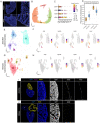This is a preprint.
Distinct features of the regenerating heart uncovered through comparative single-cell profiling
- PMID: 37461520
- PMCID: PMC10349989
- DOI: 10.1101/2023.07.04.547574
Distinct features of the regenerating heart uncovered through comparative single-cell profiling
Update in
-
Distinct features of the regenerating heart uncovered through comparative single-cell profiling.Biol Open. 2024 Apr 15;13(4):bio060156. doi: 10.1242/bio.060156. Epub 2024 Apr 5. Biol Open. 2024. PMID: 38526188 Free PMC article.
Abstract
Adult humans respond to heart injury by forming a permanent scar, yet other vertebrates are capable of robust and complete cardiac regeneration. Despite progress towards characterizing the mechanisms of cardiac regeneration in fish and amphibians, the large evolutionary gulf between mammals and regenerating vertebrates complicates deciphering which cellular and molecular features truly enable regeneration. To better define these features, we compared cardiac injury responses in zebrafish and medaka, two fish species that share similar heart anatomy and common teleost ancestry but differ in regenerative capability. We used single-cell transcriptional profiling to create a time-resolved comparative cell atlas of injury responses in all major cardiac cell types across both species. With this approach, we identified several key features that distinguish cardiac injury response in the non-regenerating medaka heart. By comparing immune responses to injury, we found altered cell recruitment and a distinct pro-inflammatory gene program in medaka leukocytes, and an absence of the injury-induced interferon response seen in zebrafish. In addition, we found a lack of pro-regenerative signals, including nrg1 and retinoic acid, from medaka endothelial and epicardial cells. Finally, we identified alterations in the myocardial structure in medaka, where they lack embryonic-like primordial layer cardiomyocytes, and fail to employ a cardioprotective gene program shared by regenerating vertebrates. Our findings reveal notable variation in injury response across nearly all major cardiac cell types in zebrafish and medaka, demonstrating how evolutionary divergence influences the hidden cellular features underpinning regenerative potential in these seemingly similar vertebrates.
Figures







Similar articles
-
Distinct features of the regenerating heart uncovered through comparative single-cell profiling.Biol Open. 2024 Apr 15;13(4):bio060156. doi: 10.1242/bio.060156. Epub 2024 Apr 5. Biol Open. 2024. PMID: 38526188 Free PMC article.
-
Reciprocal analyses in zebrafish and medaka reveal that harnessing the immune response promotes cardiac regeneration.Elife. 2017 Jun 20;6:e25605. doi: 10.7554/eLife.25605. Elife. 2017. PMID: 28632131 Free PMC article.
-
Differential Regenerative Capacity of the Optic Tectum of Adult Medaka and Zebrafish.Front Cell Dev Biol. 2021 Jun 29;9:686755. doi: 10.3389/fcell.2021.686755. eCollection 2021. Front Cell Dev Biol. 2021. PMID: 34268310 Free PMC article.
-
Turning back the cardiac regenerative clock: lessons from the neonate.Trends Cardiovasc Med. 2012 Jul;22(5):128-33. doi: 10.1016/j.tcm.2012.07.008. Epub 2012 Aug 14. Trends Cardiovasc Med. 2012. PMID: 22902092 Review.
-
Unlocking the Secrets of the Regenerating Fish Heart: Comparing Regenerative Models to Shed Light on Successful Regeneration.J Cardiovasc Dev Dis. 2021 Jan 16;8(1):4. doi: 10.3390/jcdd8010004. J Cardiovasc Dev Dis. 2021. PMID: 33467137 Free PMC article. Review.
References
-
- Godwin J. The promise of perfect adult tissue repair and regeneration in mammals: Learning from regenerative amphibians and fish. BioEssays 36, 861–871 (2014). - PubMed
Publication types
Grants and funding
LinkOut - more resources
Full Text Sources
